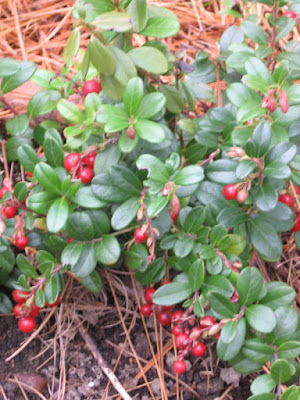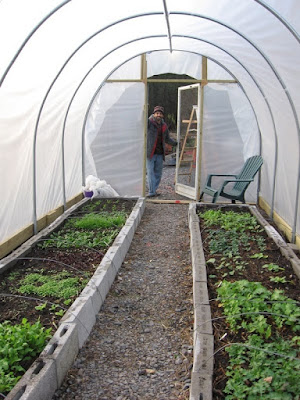 Lingonberries, native to Scandinavia, make a beautiful (and edible) ground cover under the taller blueberry bushes. A late fall treat.
Lingonberries, native to Scandinavia, make a beautiful (and edible) ground cover under the taller blueberry bushes. A late fall treat. Even as our part of the world transitions to late fall, our transition to year-round growing means that we witness new beginnings and new harvests. The salad greens planted from August through late September are our contribution to this year's Thanksgiving dinner: mesclun lettuce mix from the cold frames; arugula, spicy mustard greens, minutina, mache, claytonia, and beet leaves protected under plastic hoops. Beet, carrot, turnip and radish -- stored in the ground where they grew -- were shredded and tossed. Licorice flavored sweet cicely leaves, which I was surprised to find still surviving nestled under nearby branches, went in the salad as well.
After last year's encouraging experiment growing winter greens under low hoops (rickety ones at that, thrown together at the last moment), we put together a walk-in "high tunnel." Or as some local farmers more attractively (and perhaps more accurately) advertised, a "passive solar greenhouse." It will serve to grow a variety of semi-hardy greens (plus some transplanted dill and scallions) from now until spring, protecting them from snow and frost with a cover of plastic and warming them by trapping heat on sunny days.
The seeds went in a bit late (September, rather than August) so the semi-hardy, but day-light sensitive cooking greens are still small, but they should begin to grow rapidly in February, when the days noticeably lengthen. Here are some photos of the building process:
 Margo and Kat taking a break. In the background, a "low hoop" covers mustard greens, cabbage, and beets.
Margo and Kat taking a break. In the background, a "low hoop" covers mustard greens, cabbage, and beets. 




